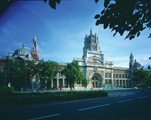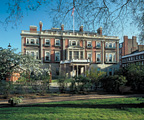Alexander Calder: Performing Sculpture
Originally published in January 2016 in American in Britain magazine Winter 2015
The current exhibit at Tate Modern, Alexander Calder: Performing Sculpture presents a retrospective of some 100 of his abstract works. He pioneered kinetic art and evolved a radically modern approach described by critics as ‘drawings in space’. Calder (1898-1976) is best known for inventing mobiles in wire and sheet metal but over the course of his long artistic career he redefined the meaning of sculpture.
Alexander Calder: Performing Sculpture
by Abby Cronin
Alexander Calder (1898-1976) may be best known for inventing mobiles in wire and sheet metal but over the course of his long artistic career he redefined the meaning of sculpture. The current exhibit at Tate Modern, Alexander Calder: Performing Sculpture presents a retrospective of some 100 of his abstract works. He pioneered kinetic art and evolved a radically modern approach described by critics as ‘drawings in space’. Absent from the exhibit are traditional sculptor’s materials such as stone, bronze and wood. Instead we are invited to explore several rooms filled with a diversity of figurative wire-based portraits as well as selections from Cirque Calder, widely displayed in the 1920s and ‘30s and right up to his death in 1976. A selection of panel works is shown together for the first time. The grace, elegance and movement of his floor-based abstract constructions invite the viewer to study them in real time. Core themes such as theatre, dance and choreography, the circus, nature, music, and the elements feature throughout. His mastery of balance and motion in all its manifestations is the touchstone of Calder’s lifelong artistic journey. The show is indeed a performance.
Calder was born in Pennsylvania to an artistic family. His sculptor father and painter mother encouraged him to pursue his interest in building things for himself. Calder wrote: I got my first tools and was given the cellar with its window as a workshop. He studied for a degree in mechanical engineering before turning his attention to an intensive study of art at the Art Students League in New York City. A lifelong involvement with the circus began when he encountered the Ringling Brothers and Barnum & Bailey Circus in Florida in 1925. His love of the circus grew into Cirque Calder developed between 1926 and 1931. Cirque Calder consisted of miniature sculptures of individual performers and circus acts which he motorised and manipulated by hand. There are examples on display, but due to their age, many appear rusted and immobile but you can see a video showing a performance of Cirque Calder in the exhibition. Learn more about Cirque Calder by calling up YouTube videos of Cirque Calder- most notably the one he presented at the Whitney Museum in New York. (http://www.whitney.org/calder)
Avant-garde artistic circles in Paris were thriving when Calder arrived in 1926. They were influential in his development. The Dadaist and Surrealist artist, Marcel Duchamp is significant because he suggested the term ‘mobile’ for the wire sculptures Calder was producing. Initially the ‘mobile’ referred to ‘kinetic art’ but as Calder’s work evolved, his mobiles came to refer specifically to free-moving creations, that is, sculptural works in which motion is the defining property. Given his background knowledge of mechanical engineering, Calder’s mobiles evolved in stages into finely balanced parts joined by lengths of wire and abstract shapes made from sheet metal. When completed, the individual elements in each mobile are capable of moving independently and whole constructions move when prompted by air movement or direct contact.
Calder’s use of wire was infinitely versatile in terms of design, scale and subject matter. His wire sculptures capture his fascination with diverse forms of performance. There is a theatrical atmosphere in which his wire sculptures of actors, dancers in a ballet, musicians and a tennis player perform. See them in Room 3 where a compelling wire portrait of the African-American cabaret dancer Josephine Baker, made in densely coiled spirals in a swirling design, makes an exotic statement. There are mechanised wire circus acrobats, strongmen, a bullfighter, even dogs and horses. The heads of his fellow artists, namely Joan Miró, Ferdinand Legér and the composer Varesè, all key figures in Calder’s development, are displayed. He captured these figures in a few strikingly expressive lines – described as ‘Wonders of Our Age: Portraits by Wire!’.
Dutch artist Piet Mondrian’s abstract work inspired Calder who wrote: When I looked at [Mondrian’s] his paintings, I felt the urge to make living paintings, shapes in motion. Mondrian’s approach was to construct lines and colour combinations on a flat surface. His flat geometric abstract forms made of coloured cardboard rectangles impressed Calder. But Calder felt the need to add movement to a simple geometric design. He adapted a strict geometric flat form so that the final work included abstract weightless movement. Several of these compositions are displayed in Room 4. They incorporate a frame within which the elements of the sculpture are suspended from wires. ‘The frames not only provide a means of support but also act like the proscenium arch of a theatre, helping to focus the gaze of the viewer.’(Tate leaflet guide) Note how his Blue Panel, 1936, a three dimensional painting with an integral suspended sculpture seems to anticipate Matisse’s shapes and colours. It is one of seven key works made between 1936 and 1937, shown together here for the first time in nearly 80 years.
A selection of Calder’s floor-based mobiles reside in the calm serene atmosphere of the larger exhibition rooms. These extraordinary works demand our attention. They are subtle, seemingly weightless and invite us to walk around them or stand still while natural motion reveals their multiple perspectives. Resting on plinths, their simple presence occupies an entire room. They engage the viewer in a virtual sense; there is no fixed viewpoint. (pictured here is Red, White, Black and Brass, 1934) Ceiling-based mobiles, by contrast, draw our attention upward. Here are sculptural mobiles inspired by the movement of the stars, scientific instruments, constellations and nature. Suspended from the ceiling, his white Snow Flurry, 1948 (pictured here held by Calder) composed of pure white snowflakes which float, drift around in circles; it sways with its own independent life. See Vertical Foliage, 1941, another compelling hanging construction.
By the early 1940s Calder had moved back to America and was living in Roxbury, Connecticut where he set up a workshop. Toward the late 1940s he travelled to Rio de Janeiro and San Paulo in Brazil to exhibit his work and was received with enormous enthusiasm. The final room in the exhibition features one of his most spectacular mobiles, the newly restored Black Widow, 1948. Loaned from the Instituto dos Arquitetos in Sao Paulo, it is displayed for the very first time in the UK. This monumental piece measures 3.5 metres by 2 metres and features 19 black metal shapes delicately linked to one another. Not only does Black Widow remind us of Calder’s tremendously successful reception in Brazil. It also symbolises the era of appreciation for modernism and is also a visual metaphor for a new and free social order.
The curators acknowledge that the 100 works in the show do not represent the entirety of Alexander Calder’s oeuvre. Their aim was not to present a comprehensive retrospective of Calder’s works but rather to highlight his output from the early 1920s in Paris and finish with works from the early 1950s. They have organised a superb exhibition and each piece is explained clearly. Once again Tate Modern together with the Calder Foundation and the TERRA Foundation for American Art has given us a wonderful opportunity to experience the work of Alexander Calder, one of the pioneers of 20th century modernism. He broke down the historic binaries of sculpture: volume and void, surface and mass, gravity and lightness and set sculpture into motion.
**********************************************************************
Additional Note: Calder is also well known for his stabiles. ** Calder devoted himself to making outdoor sculpture, known as stabiles, on a grand scale. They are made from bolted sheets of steel, many of which stand in public plazas in cities throughout the world. One well known stabile is Calder’s Saurien, 1975, permanently installed on the plaza outside the Seagram building in New York City. See it online.
_____________________________________________________________________________________________________________
Alexander Calder: Performing Sculpture 11 November 2015 – 3 April 2016 Tate Modern. www.tate.org.uk Catalogue: Alexander Calder: Performing Sculpture Edited by Achim Borchardt-hume & Ann Coxon Published by: Tate Publishing 2015 www.tate.org.uk/publishing Images courtesy Tate Modern & Abby Cronin.
Get in Touch. Contact: Abby Cronin Email: artsjournalist@abbycronin.co.uk Website: abbycronin.co.uk




